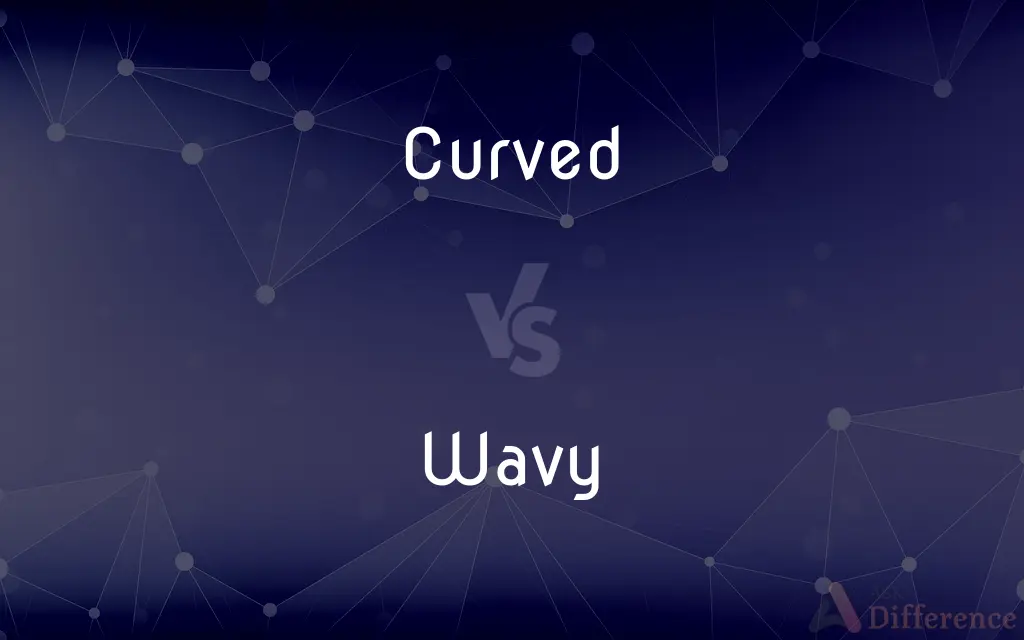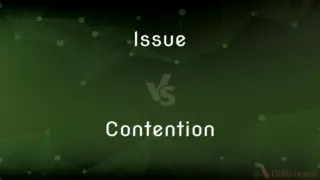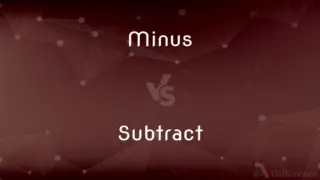Curved vs. Wavy — What's the Difference?
By Maham Liaqat & Urooj Arif — Updated on April 21, 2024
Curved refers to a smoothly bending line without angles, while wavy describes a line or surface with a series of rises and falls.

Difference Between Curved and Wavy
Table of Contents
ADVERTISEMENT
Key Differences
Curved lines or shapes follow a continuous arc without sharp angles, emphasizing smoothness and regularity in form. On the other hand, wavy patterns are characterized by more rhythmic and periodic deviations that create a series of crests and troughs, suggesting movement and fluidity.
While curved elements are often seen in architectural designs and everyday objects for ergonomic and aesthetic appeal, wavy designs mimic natural forms like waves in water or undulating sand dunes, bringing a dynamic and organic feel.
Curved structures provide an aesthetic that is sleek and often modern, ideal for creating an impression of space and flow. In contrast, wavy patterns offer a sense of rhythm and can introduce visual interest and texture to a design, making it feel more lively and engaging.
In mathematics and geometry, a curve is a broad term that encompasses any non-straight line, including circles and ellipses, that can be described by a mathematical function. Whereas, wavy lines specifically refer to oscillating patterns that frequently appear in functions like sine and cosine waves.
In terms of usage, curved forms are preferred in applications requiring simplicity and efficiency, such as in roads or tools. Wavy forms, however, are often chosen for their decorative potential, found in fashion, textiles, and art to evoke a sense of movement and natural beauty.
ADVERTISEMENT
Comparison Chart
Definition
Smoothly bending without sharp turns
Characterized by oscillations or waves
Visual Appeal
Sleek and modern
Dynamic and organic
Common Uses
Architecture, tools, roads
Art, textiles, fashion
Representation
Continuous arc
Series of crests and troughs
Mathematical Representation
Described by functions like parabolas
Often described by sine and cosine functions
Compare with Definitions
Curved
Formed or bent into a non-linear shape.
The lamp featured a uniquely curved stand.
Wavy
Having a form that rises and falls.
The wavy trim on the dress added a playful touch.
Curved
Relating to the shape of a circle or ellipse.
The curved edge of the table is designed to prevent injuries.
Wavy
Not straight, with multiple curves.
The wavy path through the garden was a delight to explore.
Curved
Describing an object that follows an arc.
The curved trajectory of the ball mesmerized the audience.
Wavy
Characterized by movement resembling waves.
The crowd's wavy motion indicated excitement.
Curved
Pertaining to bending without breaks.
The bridge’s curved design was both functional and aesthetic.
Wavy
Marked by successive curves and dips.
Her wavy hair flowed beautifully in the breeze.
Curved
Having no angles or sharp corners.
The road curved smoothly around the mountain.
Wavy
Resembling waves, as in texture or pattern.
The wavy lines of the painting suggested a river.
Curved
A line that deviates from straightness in a smooth, continuous fashion.
Wavy
Abounding or rising in waves
A wavy sea.
Curved
A surface that deviates from planarity in a smooth, continuous fashion.
Wavy
Marked by or moving in a wavelike form or motion; sinuous.
Curved
Something characterized by such a line or surface, especially a rounded line or contour of the human body.
Wavy
Having curls, curves, or undulations
Wavy hair.
Curved
A relatively smooth bend in a road or other course.
Wavy
Characteristic or suggestive of waves.
Curved
A line representing data on a graph.
Wavy
Wavering; unstable.
Curved
A trend derived from or as if from such a graph
"Once again, the politicians are behind the curve" (Ted Kennedy).
Wavy
Rising or swelling in waves.
Wavy seas
Curved
A graphic representation showing the relative performance of individuals as measured against each other, used especially as a method of grading students in which the assignment of grades is based on predetermined proportions of students.
Wavy
Full of waves.
Wavy swimming pool
Curved
The graph of a function on a coordinate plane.
Wavy
Moving to and fro; undulating.
Wavy bridge
Curved
The intersection of two surfaces in three dimensions.
Wavy
Having wave-like shapes on its border or surface; waved.
Wavy hair
Curved
The graph of the solutions to any equation of two variables.
Wavy
Moving up and down relative to the surface; undulate.
Curved
(Baseball) A curve ball.
Wavy
(heraldry) Undé, in a wavy line; applied to ordinaries, or division lines.
Curved
(Slang) Something that is unexpected or designed to trick or deceive.
Wavy
(slang) drunk
Curved
To move in or take the shape of a curve
The path curves around the lake.
Wavy
Alternative form of wavey.
Curved
To cause to curve.
Wavy
Rising or swelling in waves; full of waves.
Curved
(Baseball) To pitch (a ball) with a curve.
Wavy
Playing to and fro; undulating; as, wavy flames.
Let her glad valleys smile with wavy corn.
Curved
To grade (students, for example) on a curve.
Wavy
Undulating on the border or surface; waved.
Curved
Having a curve or curves.
Wavy
In waves
Curved
Simple past tense and past participle of curve
Wavy
Having wrinkles or waves
Curved
Not straight; having or marked by curves. Opposite of straight.
Curved
Curved with the micropyle near the base almost touching its stalk; - of a plant ovule. Opposite of orthotropous.
Curved
Not straight; having or marked by a curve or smoothly rounded bend;
The curved tusks of a walrus
His curved lips suggested a smile but his eyes were hard
Common Curiosities
What are some common examples of wavy patterns?
Examples include ocean waves, curly hair, and ruffled fabrics.
How is a wavy line different from a curved line?
A wavy line consists of multiple curves and dips, resembling a sequence of waves, whereas a curved line is a single, smooth bend.
Why might a designer choose a curved shape over a wavy one?
A designer might choose curved shapes for simplicity and streamlined aesthetics.
Can a surface be both curved and wavy?
Yes, a surface can have elements of both, such as a wavy pattern imposed on a generally curved form.
What are some common examples of curved objects?
Examples include circles, ovals, and arches in architecture.
Why might a designer choose a wavy pattern?
Wavy patterns are chosen for their dynamic visual appeal and to evoke natural elements.
What does it mean for a line to be curved?
A curved line bends smoothly, forming a continuous arc without sharp turns.
How do curved and wavy lines affect the perception of movement?
Curved lines suggest smooth and continuous movement, while wavy lines suggest rhythmic and more dynamic motion.
How do curves and waves differ in mathematical terms?
Curves can be any non-straight line described by a function, while waves specifically refer to periodic oscillations like those seen in sine and cosine functions.
Are curved designs more modern than wavy designs?
Curved designs tend to appear more modern and sleek, while wavy designs offer a more playful and organic look.
Share Your Discovery

Previous Comparison
Issue vs. Contention
Next Comparison
Minus vs. SubtractAuthor Spotlight
Written by
Maham LiaqatCo-written by
Urooj ArifUrooj is a skilled content writer at Ask Difference, known for her exceptional ability to simplify complex topics into engaging and informative content. With a passion for research and a flair for clear, concise writing, she consistently delivers articles that resonate with our diverse audience.














































